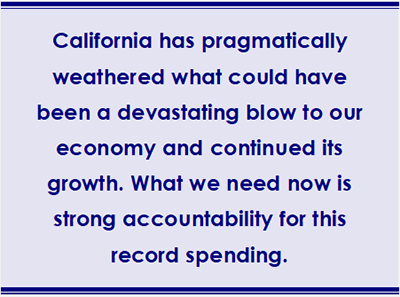You can also view this newsletter as a PDF.

Controller Yee Highlights Governor's Budget Blueprint
On January 10, Governor Gavin Newsom released his proposed Fiscal Year 2022-23 California State Budget. Dubbed “The California Blueprint,” the proposal focuses on five areas the governor characterizes as existential threats. These include fighting COVID-19 with science, combating the climate crisis, confronting homelessness, tackling the high cost of living in California, and keeping our communities safe.
 In response to the proposed budget, Controller Yee stated, “I am encouraged the governor continues to invest California’s budget surplus in its people and its natural resources, while working to retire unfunded liabilities that threatened to weigh down our economy in the long term. California continues its efforts to ensure its people are housed and receiving critical services. We are working to conserve our incomparable lands and waters, while properly managing our forests to protect communities in the face of climate-driven wildfires.”
In response to the proposed budget, Controller Yee stated, “I am encouraged the governor continues to invest California’s budget surplus in its people and its natural resources, while working to retire unfunded liabilities that threatened to weigh down our economy in the long term. California continues its efforts to ensure its people are housed and receiving critical services. We are working to conserve our incomparable lands and waters, while properly managing our forests to protect communities in the face of climate-driven wildfires.”
Yee, the state’s chief fiscal officer, stressed the need for accountability, concluding, “California has pragmatically weathered what could have been a devastating blow to our economy and continued its growth. What we need now is strong accountability for this record spending. Californians deserve and should expect to see measurable results from these investments as they apply to the crisis of homelessness, climate mitigation, and other critical areas.”
Overview
The state now has a projected surplus of $45.7 billion, which includes $20.6 billion General Fund, $16.1 billion in additional Proposition 98 funds for K-14 education, and $9 billion in reserve deposits and supplemental pension payments.
Reserves
Governor Newsom asserts the proposed budget is balanced on a strong fiscal foundation. The budget proposal contains $34.6 billion in reserves:
Revenues
Total General Fund revenues for FY 2022-23 are estimated at more than $197.28 billion, and Special Fund revenues are estimated at nearly $64.19 billion, for a total of $261.47 billion.
The proposed budget anticipates California’s “big three” revenue resources – personal income tax ($134.1 billion), retail sales and use tax ($46.8 billion), and corporation tax ($23.7 billion) – will account for 78.2 percent of all revenue collected by the state. Of particular note, capital gains tax revenue for FY 2022-23 is expected to reach $23.3 billion on total capital gain realizations of $232.7 billion, one of the highest levels recorded.
Expenditures
Total expenditures for FY 2022-23 are estimated at $286.47 billion. This total comprises the General Fund ($213.1 billion), Special Funds ($65.3 billion), and Bond Funds ($8.04 billion).
Proposition 98 Expenditures
The upward revision of General Fund revenues resulted in significant increases in the school funding guarantee. Proposition 98 funding for K-12 schools and community colleges for FY 2022-23 is $102 billion – an increased investment of $8.2 billion above 2021 levels. Proposed per pupil spending of $20,855 is the highest level of funding ever provided for California schools.
“Gann” Appropriation Limit
The proposed budget projects the State Appropriations Limit, or "Gann Limit," was likely exceeded for FY 2020-21 and FY 2021-22. Any funds above this limit are constitutionally required to be split evenly between schools and a tax refund. An updated calculation of this limit, and proposals to address it, are expected to be included in the May Revision.
Identified Budget Risks
The governor’s proposed FY 2022-23 budget specifically calls out six potential downside risks that could have an adverse impact on the budget:
- Pandemic-related risks;
- Constrained growth as the labor market recovers from pre-pandemic levels;
- Decreased consumption due to persistent inflation;
- Increased borrowing costs triggered by Federal Reserve interest rate policies;
- Stock market volatility; and
- Climate change.
Budget Opportunity
On a positive note, the Administration highlights the possibility that major federal legislation – such as the Build Back Better framework – could infuse addition federal dollars for priority social programs.
Economic Forecast Highlights
California’s labor force is projected to recover to its pre-pandemic level by the third quarter of 2022, in line with national trends. California’s unemployment rate is projected to steadily decrease to its pre-pandemic record low of 4.2 percent by 2024.
California’s average wage growth was strong through the third quarter of 2021, which is expected to translate into strong growth of 6.1 percent for the entire year. Real wage gains are projected for both high-wage and low-wage earners starting in 2023, as the economic recovery strengthens and inflation abates.
California’s headline inflation is projected to decelerate to pre-pandemic trends of slightly more than 3 percent by the first quarter of 2023, after averaging 4.2 percent and 3.8 percent in 2021 and 2022, respectively.
California’s total personal income is projected to decelerate to below pre-pandemic rates in 2022 before accelerating to an average annual growth of 5.3 percent between 2023 and 2025.
California’s housing permits are projected to average 120,000 units in 2021, increasing to 149,000 by 2025.

Controller Begins Final Year as
Chair of State Lands Commission
As California State Controller, Betty T. Yee serves on approximately 70 boards and commissions that focus on a wide range of issues. Among them is the California State Lands Commission (SLC), which oversees the state’s Public Trust lands. In even-numbered years, like 2022, the State Controller serves as chair of SLC.
About the Commission
Established in 1938, SLC manages 4 million acres of tide and submerged lands and the beds of natural navigable rivers, streams, lakes, bays, estuaries, inlets, and straits. These lands, known as sovereign or Public Trust lands, stretch from the Klamath River in the north to the Tijuana Estuary in the south, and from three miles offshore of the Pacific Coast in the west to Lake Tahoe in the east.
The Commission also monitors sovereign land granted in trust by the California Legislature that generally consist of prime waterfront lands and coastal waters, including our ports. The Commission issues leases for use or development; resolves boundaries between public and private lands; safeguards the public’s right to access natural navigable waterways and the coastline; and preserves irreplaceable natural habitats for wildlife, vegetation, and biological communities.
SLC also protects state waters from the introduction of marine invasive species and works to prevent oil spills and protect the marine environment at marine oil terminals, offshore oil platforms, and production facilities.
Strategic Planning
In the months leading up to her first year as chair, Controller Yee convened a diverse group of shareholders to reach agreement on the first five-year strategic plan in the Commission’s history. The plan served as a blueprint for the work ahead, positioning SLC as a leader in land and resource management, prioritizing transparency and environmental protection, and leveraging technology to increase public engagement and help SLC be more innovative in its service to the people of California.
Controller Yee places the utmost importance on environmental justice and tribal engagement in all of the Commission’s work. The first strategic plan led to the adoption of a meaningful Tribal Consultation Policy, and SLC’s first Environmental Justice Policy. These changes made possible the return of 40 acres of tribal land in Inyo County to the Lone Pine Paiute-Shoshone people in 2020, one of Controller Yee’s proudest achievements during her tenure on SLC.
Other notable accomplishments achieved through SLC’s first-ever strategic plan included:
- Dedicating more than 16,000 acres to the California Coastal Sanctuary;
- Plugging and abandoning dozens of coastal oil wells ahead of schedule and under budget;
- Entering into a landmark collaboration agreement to inform the development of a coastal access program at Hollister Ranch in Santa Barbara County; and
- Launching a new web-mapping application for state waters offshore in San Diego, to help users better understand the dynamic ocean space and ocean-related data.
SLC is now operating under the 2021-25 Strategic Plan, which dedicated stakeholders met virtually through the pandemic to complete. The plan builds on the accomplishments of the first strategic plan with a focus on the Commission’s foundational values of inclusion, accessibility, equity, sustainability, and environmental justice.
Throughout Controller Yee's tenure on SLC, she has worked to address the threat of sea-level rise, the scourge of ocean plastics, the needed decommissioning of offshore oil wells, and the growing effects of climate change, with a priority to protect the long-term health of our ocean, marine and coastal resources, waterways, and lands — and supporting the vital blue and green economies.
Controller Yee will serve her final term as SLC chair in 2022. With the time she has remaining, Controller Yee remains committed to a careful, comprehensive, and fiscally responsible approach to moving away from offshore oil and gas operations.
Expanded Role in Ocean Sector
In the years Controller Yee is SLC chair, her responsibilities are expanded to include membership on the California Coastal Commission and the Ocean Protection Council (OPC).
OPC is charged with ensuring California maintains healthy, resilient, and productive ocean and coastal ecosystems for the benefit of current and future generations. The Council is committed to basing its decisions and actions on the best available science, and to promoting the use of science among all entities involved in the management of ocean resources – a priority shared by Controller Yee and SLC. In 2020, Controller Yee joined her colleagues in adopting the 2020-2025 Strategic Plan, a bold and comprehensive vision and set of actions for protecting our coast and ocean and all the inherent value and benefits they bring.
Established by voter initiative in 1972, the Coastal Commission partners with coastal cities and counties to plan and regulate the use of land and water in the coastal zone. Development activities such as construction of buildings and other activities that change the intensity of use of land or public access to coastal waters generally require a coastal permit from the Coastal Commission or the local government. The Commission is committed to protecting and enhancing California’s coast and ocean for present and future generations.